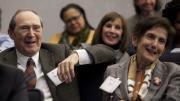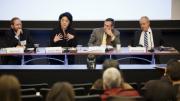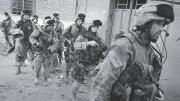The Harvard Initiative on Learning and Teaching (HILT), unveiled in October, was inaugurated on Friday, February 3, with an all-day, invitation-only symposium principally featuring, and aimed at, faculty members, at the Northwest Building on Oxford Street. Ordinarily one hears “teaching and learning,” but this initiative deliberately inverted the order of the key words to stress the primacy of learning. HILT is the fruit of a $40-million gift from Gustave M. Hauser, J.D. ’53, and his wife, Rita E. Hauser, L ’58, who both attended the symposium and participated actively during the question periods.
It was, by Harvard’s standards, a star-studded gathering. More than 300 participants convened from all Harvard’s faculties; they were, for the most part, senior professors and deans—plus invited panelists with special expertise in the field. The day’s panels consistently operated at a high intellectual level, with audience participants asking questions that indicated long involvement with the issues under review. There were also distant participants who took part via live streaming. Throughout the day, an array of about two dozen displays highlighted options available at museums, libraries, and teaching and learning centers in different part of the University. The registration packet even had some digital swag: a USB flash drive preloaded with a variety of teaching and learning resources at Harvard.
President Drew Faust welcomed everyone with remarks that accented the connection between “thinking and making.” In this she tapped into a theme of later discussions: the way that learning deepens when students have hands-on experiences with the material studied. Faust mentioned one such example, the involvement of Harvard Kennedy School students with the neighboring city of Somerville, in a venture of mutual learning and contribution focused on governing an urban municipality.
Director of institutional research Erin Driver-Linn, a central figure in organizing the symposium, gave an overview of HILT’s operating process, sketching out a cyclical model of testing innovations (engage —> experiment —> evaluate —> extend —> engage). She noted that the first year of Hauser support would launch many pilot studies across the University, and that HILT had already received 255 letters of intent to apply for grants. (Proposals will be winnowed by a faculty panel, with those selected for further development and possible funding announced in early spring.) She quoted the late historian of science Thomas Kuhn ’44, Ph.D. ’49, JF ’51, to the effect that there is never a genuine paradigm shift until there is enough consensus on what the new paradigm is.
The Science of Learning
Cabot professor of social ethics Mahzarin Banaji was facilitator for the day’s first panel, on “The Science of Learning.” She noted that while mother birds appear to “teach” their young to find worms, psychologists have asserted that humans have “a specialized capacity to extract generalized knowledge from the behavior of others.” But many things we believe about learning simply aren’t so, she added. There is, for example, a broadly held belief that individuals have different ways of learning: that there are visual learners, auditory learners, those who learn from images, and so on; hence, educators are advised to match teaching methods to each person’s characteristic learning style. But there is no research supporting the idea that such matching influences learning outcomes.
Nobel laureate Carl Wieman, a pioneer in effective science education and associate director of science at the White House Office of Science and Technology Policy, noted that although much is known (from cognitive psychology, brain science, and college classroom studies) about thinking and learning, this knowledge is almost never applied to teaching techniques. “Abstract ideas are not enough,” he said, drawing a parallel to bridge-building, where understanding the relevant principles of physics will not get a bridge built. Wieman cited a few well-established results from research:
- trying to teach anything to someone whose attention is divided will impair learning;
- unnecessary cognitive overload (jargon, complex figures) impede the learning process;
- covering a topic, testing, then considering the job done may not result in retention of what was learned; and
- telling something to listeners who do not process the information in some way will not create long-lasting knowledge.
Roddy Roediger, McDonnell Distinguished University Professor at Washington University in St. Louis, described some of his research on college students, whom he called “the Drosophilia of my field.” He observed that students report their study habits as stressing “reading the textbook, highlighting, and underlining.” However, Roediger said, “You learn a lot more from exams than from reading material.” Neither professors nor students like tests, but research shows that frequent assessments outpace more study time as a way to retain information. One study even showed that “the more you study, the less you learn.” Roediger asserted that “You need to practice retrieval—there’s a huge benefit in doing this.”
Johnstone Family professor of psychology Steven Pinker spoke on writing. After paying due respects to The Elements of Style, the classic writing primer by William Strunk Jr. and E.B. White, Pinker cited several criticisms of the book and noted that “it should not be the basis for writing instruction in the twenty-first century.”
Pinker told of a psychology experiment with three-year-old children. A child came into a room and received an M&M candy box, but opened the box to find pencils inside. When asked what another three-year-old who got his own M&M box would expect to find inside, the child answers, “Pencils.” Pinker used this example to elucidate “the chief contributor to opaque writing: it is hard to know what it is like for someone not to know what you know.” He went on to say that a writer has to “anticipate and minimize the reader’s memory load.”
In the question session, he compared memories to websites: “They need links to be accessible.”
Innovation in Higher Education
John Palfrey, Ess professor of law, facilitated the session on “Innovation in Higher Education.” He reinforced Roediger’s point on the value of assessment by mentioning that Gottlieb professor of law Elizabeth Warren (now on leave to pursue election to the U.S. Senate) “called on everyone every day” in her classes.
Clark professor of business administration Clay Christensen opened with a question: “Why is success so hard to sustain?” His provisional answer, that “the reason companies cannot sustain success is that they follow the principles of good management that we teach at Harvard Business School,” triggered uproarious laughter. In industry after industry, he pointed out, established, successful companies like General Motors get dethroned by “someone who comes in at the bottom of the market with a simple, affordable product that people can afford, and then they move up.” He noted that Toyota, for example, began not with the Lexus, but the Corona.
There are exceptions, like hotels. Holiday Inn never became a more upmarket brand after its low-end entry; neither did McDonald’s. There needs to be “something about the business model or technology that is extendable upward,” Christensen said. For a long while, that also seemed to be the case in higher education. But given the power of the online world and its teaching modules, “now, higher education has a technological core, and so it is now disruptible” by low-end competition. (Read Christensen’s recent Harvard Magazine essay on disruptive change in higher education.) He told how the online University of Phoenix could show his lectures to 135,000 M.B.A. students, and was “spending $200 million per year to make teaching better.”
Cathy Davidson, Franklin Humanities Institute professor of interdisciplinary studies at Duke, started by explaining that “disruptive things happen as reactions to the status quo, but we don’t see the status quo—it’s like the air we breathe.” Consequently we are “doing a fine job of training students for the twentieth century.” Davidson explained that the research university was designed to solve the problems of the Industrial Age and had its basis in the structure of disciplinary specialists teaching cleanly divided subjects. But in the twenty-first century, even the high-level distinctions among natural and social sciences and humanities “make very little sense. It takes disruption to break through those silos.” Returning to the theme of high technology, she declared, “If we can be replaced by a computer screen, we should be.”
In the discussion period, Christensen observed that during his 20-year career at HBS, “The intensity of curiosity [among students] is down. They don’t know how injection molding is done, and they don’t care.” He predicted, “We’ll see a bifurcation of research and teaching, and we’ll need fewer teachers over time.” The online future of teaching “will be a great thing,” he said. “We’ll commoditize teaching at HBS.”
Davidson praised the online teaching of the nonprofit Khan Academy, established by Salman Khan, M.B.A. ’03, a place “doing back-end research on how people learn.” Balkanski professor of physics and applied physics Eric Mazur responded from the audience that the Khan Academy approach, like “99 percent of the use of technology in education,” is essentially “old wine in new bottles,” as it uses the classic lecture technique of one-way transmission of information. Referring to earlier colloquies, Mazur said he was not so much interested in “scaling up the number of people who learn” as in being able to “produce better learning.” (See further discussion by Mazur below and in “Twilight of the Lecture,” on his approach to active learning.)
Christensen said that “a student’s job is to feel successful. And school doesn’t help most students feel successful.” He mentioned seeing three teenaged girls walking together on the sidewalk, all of them texting other people. “For my generation, that is so rude,” he said. “But you can’t count out the idea that this generation might prefer the online experience.”
Davidson noted that enrollment rates at the online University of Phoenix “dropped dramatically last year,” and wondered if some disillusionment with online learning was setting in.
Innovation in Practice
After a break for lunch, five concurrent sessions divided the participants into smaller groups to explore “Improving Learning through Innovation in Practice: Demonstrations and Ideas.” Bridget Long, Xander professor of education and economics at Harvard Graduate School of Education, facilitated one such session, in which faculty members, essentially, offered mini-classes to their peers as examples of inventive pedagogy. The session began with Thomas Kelly, Knafel professor of music, delivering a condensed version of his multimedia lecture on the 1913 Paris premiere of Le sacre du printemps from his celebrated “First Nights” course. Jennifer Leaning, Bagnoud professor of the practice of health and human rights at Harvard School of Public Health, followed with vivid photographs documenting the human suffering in Darfur. Michael Hays, Noyes professor of architectural theory at the Graduate School of Design, discussed form, concept, signifier, and sign, along with photographs contrasting, for example, Renaissance and Baroque styles. “Think of them as ideologies,” he urged. “Social imaginaries, cognitive maps.”
Mazur capped the session with a talk on his practice of peer instruction, giving the audience an experience of it after posing a physics question that evoked three different answers from the academic crowd in the room, and asking participants to discuss the reasons for their choices with each other. “You can’t sleep through my class because your neighbor will start talking to you,” he declared. Mazur opined that students do not pay close attention in lectures, think that they know the material after having heard it, and are not confronted with their misconceptions—generating a false sense of security. He related one complaint he often hears about peer instruction from students: “Professor Mazur is not teaching us anything—we have to learn it all ourselves.” He also said, “Our approach to testing only rewards perfection—but the road to innovation is littered with mistakes.”
The Continuing Importance of Presence
The final symposium was “Looking to the Future: An Interactive Discussion with Attendees.” Provost Alan Garber facilitated, opening by declaring that “Experimentation is something we’d like to see much more of at Harvard.” He argued for separating innovation from the evaluation of its effects, as “innovators do not always make good evaluators.” Garber cited Charles William Eliot, Harvard’s president from 1869 to 1909, on the importance of building character in students, and declared that this goal remains in place today: “Think of how we feel about what our students do later on in life.” (Though he added, “I can’t think of what metrics we use for character.")
David professor of business administration Youngme Moon—who as the Business School’s senior associate dean for the M.B.A. program has led the creation of the new experience-oriented field course that sent students around the world in January—advocated changing “not what great looks like, but what average looks like” as a way to “shift the entire distribution to the right.” She told of a sign in her office that reads, “Excellence = design x culture.” It would be desirable, she said, “to change the culture so that the spirit of innovation permeates the entire faculty and student base.” (Read more about Moon and HBS’s “FIELD course” here.)
Former Tufts University president Lawrence Bacow, now a member of the Harvard Corporation, cited a faculty proverb: “We all teach for free but we get paid to grade.” He speculated that innovation in learning will eventually mean that “we will be released from the tedium that comes with grading.” He also cautioned that “any program looks good if you only look at its benefits and not its costs. All ways of improving the teaching/learning environment will only add costs to our system. That can’t go on forever. These things come to an end and usually it’s not pretty.” The answer, Bacow suggested, is “to improve productivity—or we will lose the support we have received, historically, from the public and the government.”
Bass professor of government Michael Sandel, after musing that “we might all go the way of the Hummer,” asked, “What is the importance of presence of teacher to student, and of students to each other?” He also wanted to know to what extent the Internet recasts the question of presence.
The Internet makes possible certain types of global classroom; a video of one version of Sandel’s “Justice” course showed students from China, Japan, and Harvard addressing the same moral questions, with contrasting opinions on them. But given audio and video lag time, “videoconferencing won’t work that well” as a way to realize global classrooms, Sandel said. “Actual physical presence matters a lot. You have to enable students to see each other.” There is also the camaraderie students have with each other; after the three-nation course, students volunteered to keep up with each other on Facebook, until they realized that the Chinese didn’t have Facebook.
Online technology also, obviously, could greatly expand course enrollments. But, as Sandel asked, “If we were to put this out free for everyone in the world, students might say, ‘What about the fact that we paid $50,000 a year to do this?’” In the discussion session, Bacow followed up by noting, “Our capacity to reach others becomes inhibited as our unit price continues to grow.”
In the discussion, Mazur raised the question of how to get the faculty as a whole to innovate in its teaching practices. Garber had one answer: “When people see success, they want to emulate it. The challenge to the innovators in the room is how to be evangelists among your colleagues. We will support you in the central administration. But you know how easy it is to push faculty to do things they don’t want to do.”









